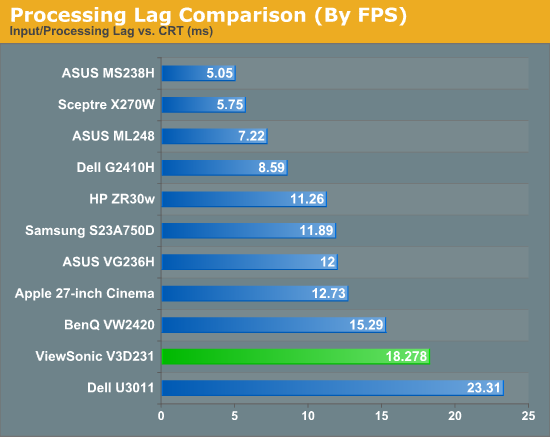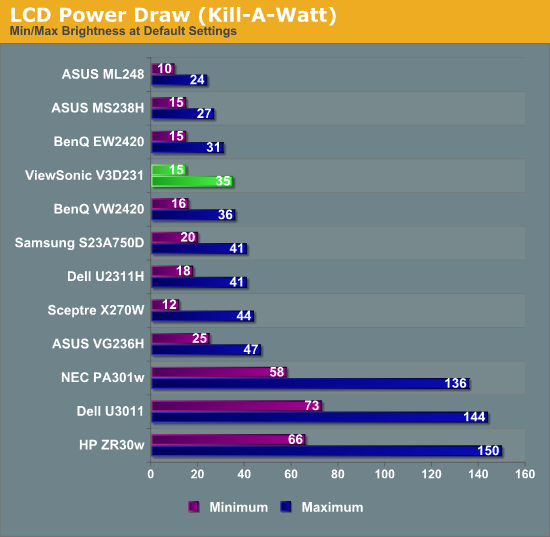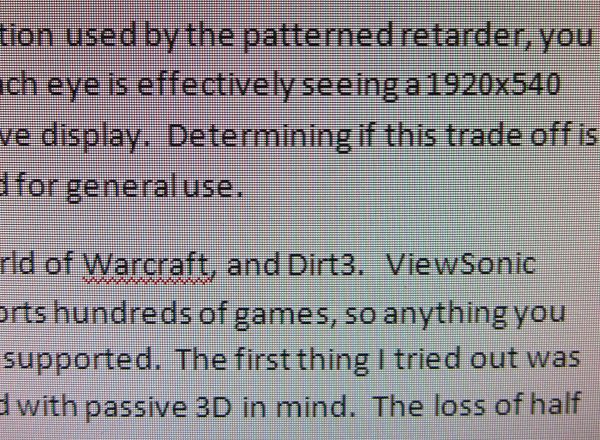ViewSonic V3D231 3D Display - The Passive Approach
by Chris Heinonen on December 30, 2011 12:00 AM ESTOf course anyone buying this ViewSonic monitor is going to be buying it for 3D use as well. As I touched upon earlier, passive 3D has some advantages over active 3D, including cheaper glasses. The main advantage in my view is that I find it far easier to watch and enjoy than active 3D. For people like myself, the opening and closing of the lenses in active 3D glasses leads to headaches and discomfort in a short period of time, and we generally avoid it. Passive 3D has none of that since your lenses are always open. This also allows more light to pass through than with an active 3D display. Additionally the technology used in passive 3D should virtually eliminate any ghosting or crosstalk in the 3D image.
Unfortunately, passive 3D does have one major downside: due to the polarization used by the patterned retarder, you only get half the effective vertical resolution from a display. Each eye is effectively seeing a 1920x540 image instead of a 1920x1080 image as you would with an active display. Determining if this tradeoff is worth it requires trying out both types of display, both for gaming and for general use. Examples of text from this review can be seen below, both with and without the glasses between the camera and screen.
For gaming tests, I relied on three main games: Half Life 2, World of Warcraft, and DiRT 3. ViewSonic provides the TriDef 3D software with the monitor that supports hundreds of games, so anything you have from the past few years has a very good chance of being supported. The first thing I tried out was World of Warcraft, and this was certainly not a game designed with passive 3D in mind. The loss of half the resolution renders the text unreadable, which is a big no-no in an MMORPG or other genre with lots of reading. During normal gameplay it was fine, but you can’t read anything that is on the screen while in 3D mode and wearing the glasses.
Half-Life 2 and DiRT 3 prove to be much better examples for the V3D231, as there is a good sense of depth in the rendering and not much in the way of artifacts. You still see some ghost objects, but I found the glasses much easier to wear and use than any active 3D glasses. The TriDef software allows for you to adjust the sense of depth and other 3D parameters in game, which lets you determine what is easiest to view. Objects that appear to come out of the screen, instead of going back into the screen, can often cause more eye strain and fatigue, so if you find yourself getting tired you can reduce the level of depth in the image to compensate. While I think that 3D can add something to the experience, passive 3D does add a lot of aliasing due to the loss of vertical resolution, and I feel that a 120Hz refresh rate made for a more natural, immersive experience than passive 3D does.
For watching movies, passive 3D is a tossup once again. The recent 3D Blu-ray release of The Lion King looked just fantastic. Crosstalk and ghosting were practically non-existent I found, and the loss of resolution really didn’t bother me much with the animation. However, as soon as I put on the 3D Blu-ray of Tron Legacy, I found myself wishing for an active 3D display. The combination of black backgrounds and bright, angled lines led to aliasing all over the image and was really quite distracting. Tron is my worst case disc for passive 3D, as it seems to show off the downsides more than anything else, and that is the case here.
Running crosstalk benchmarks, the ViewSonic seems to do much worse than the prior active 3D Samsung, but the results on the ViewSonic are incredibly dependent on my head angle and location. If I shift just an inch to the side I get totally different numbers, so I tried to maintain my head in the dead center. Since it is a passive display, the numbers seem much higher than they should be, but I made certain that every measurement was as accurate as I could make it.

For non-3D gaming, I put the ViewSonic through the usual lag tests, with both faster and regular response enabled. I found no differences between the modes in testing, so there is only one set of numbers presented here. The ViewSonic averages just about 1 frame of lag in comparison to the ViewSonic CRT next to it. I had no issues using it for general gaming, but people that need better response will want to look at some other options.

Hooked up to the Kill-A-Watt, the ViewSonic maxes out at 35 watts with a full backlight, and 15 watts with the backlight at minimum. This is higher than other TN displays with LED backlights and closer to IPS or VA panels. Given the higher power usage I wish the light output had been higher than it is.













42 Comments
View All Comments
MattM_Super - Wednesday, January 4, 2012 - link
I also disagree with you about 60hz flicker not being perceptible. 60hz CRTs drove me nuts and the flicker in Nividia's 3d vision is similarly annoying. I don't seem to have any problems with theater 3d using polarized glasses.As far as 60hz vs 120hz LCDs go, 60hz monitors don't flicker noticeably since they are continuously lit. However, 120hz (with 120fps) has less tearing and ghosting in horizontally moving shapes and clearer textures when turning or strafing in 1st person games
MattM_Super - Wednesday, January 4, 2012 - link
I should add that 60hz flicker is like a very high pitched tone. Some people can hear a loud annoying eeeeee, while others just don't hear anything at all. I know people (myself included) who instantly notice when they sit down in-front of a 60hz CRT (or any CRT set to 60hz) and others who can't tell a difference in a blind test.robinthakur - Wednesday, January 4, 2012 - link
Completely agree. The first monitor I got years ago supported 60Hz, 100Hz and 120Hz. At 60, viewing was flickery and uncomfortable with ahigh pitched CRT whine, at 100 was smooth and 120 was a dream. Even if the display switched back to 100Hz without me initially realising, I soon got a feeling that it wasn't as smooth as it could be. In the same way, I find it incredibly hard to like games which play at less than 60fps. The difference is absolutely noticeable, and enhances everything about the game's animation when it is at or above 60. I probably got this from the Dreamcast with its VGA box and refused to play games that didn't support it because they were the games which didn't run at 60fps (with the exception of the Capcom fighters) lolrobinthakur - Wednesday, January 4, 2012 - link
I'm afraid, as an owner of both passive 3d and Active 3d TV's I would completely disagree with you. I owned a Panasonic VT30 50" Active 3D display and got absolutely sick of the headaches, eye-strain, dim images and flickering I got from my window behind the TV. In addition, you have to charge the glasses all the time and have a spare set available in case the charge goes flat whilst watching a movie. At £50 per set, they were too expensive to buy a large enough number for the family to watch TV at the same time, so the feature was used very sparingly.I happened to see an LG passive screen at my mate's house a couple of months ago and had my eyes opened to the potential of 3D in the home. After having slagged off his choice for the 'halved' vertical resolution, I had to admit my mistake as it was so comfortable watching the image and at the correct viewing distance, I couldn't perceive any negative effects such as obvious line structure from the FPR. The long and the short is that I have replaced my Panasonic with a shiny new LG passive Cinema 3D set (which comes with 7 pairs of glasses) and would not go back if they paid me. We now watch a great deal of 3D OTA and Blu Ray 3D programming and it has made the format people-friendly.
The choice might not be superior on paper, hence my original purchasing decision, but it is borderline scandalous that they majority face of 3D in the home at this time is a technology which is simply more trouble than it is worth for the majority of normal people without dedicated Home cinemas. Samsung/Sony/Pansonic et al risk the failure of the whole 3D industry with their current technology IMO.
This Viewsonic display is not best of breed either when it comes to passive, so don't write off the technology based on it.
Sabresiberian - Friday, December 30, 2011 - link
LG makes IPS panels with what they call film-type pattern retarder (FPR) technology. I'm not sure how that is different from what this monitor has, or if it's even different.I'm not thrilled with the idea of these monitors because they don't use or promote 120Hz screens, which is something I'd really like to see become an industry standard. I'm also rather disappointed to see interlacing make a comeback, I thought that was dead. Still it offers something for those who can't use the shutter based 3D, which is a good thing, I think.
The most important part, for me, though is that LG is using this on IPS panels. It's the first time 3D has been sold on an IPS panel, and that is, in my opinion, good progress and I congratulate LG for that.
Hopefully, LG will see fit to send Anandtech a panel for testing purposes.
;)
Conficio - Friday, December 30, 2011 - link
Which model is the LG IPS 3D Display?Death666Angel - Saturday, December 31, 2011 - link
LG 27" DM92 will be an IPS with 3D capabilities and 1440p resolution. At least that's what the news say. We'll know more when CES comes.Earballs - Sunday, January 1, 2012 - link
"I'm not thrilled with the idea of these monitors because they don't use or promote 120Hz screens, which is something I'd really like to see become an industry standard"+ all the rep in the world
robinthakur - Wednesday, January 4, 2012 - link
Why can't we have 120fps IPS passive screens? I'm holding out for that because I can't use Active 3D due to the headache inducing flicker I can perceive (the same reason I can't watch DLP projected images using a colour wheel - I see rainbows)imaheadcase - Friday, December 30, 2011 - link
I don't know anyone who even cared about 3d movies, let alone to see one specifically for that.